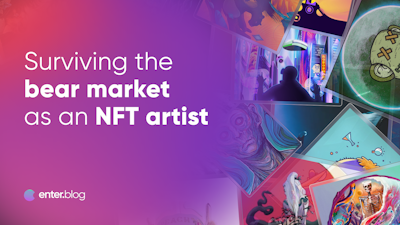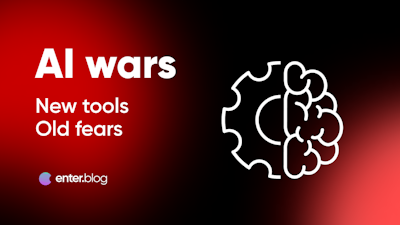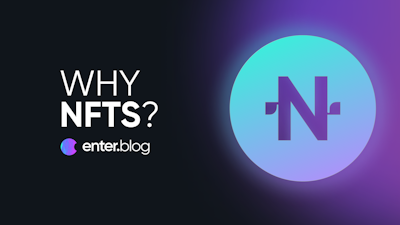
Web3 - What’s the buzz about?
What some believed was just a fad, is today shaping the way we approach everything from tech and finance to art and gaming. Web3 is on everybody's lips, and for good reason. In this article, we discover the essence of Web3, and why it’s important.

Whether you’ve followed the space since the birth of Bitcoin or just recently started to dive into the topic of blockchain, you’ve probably heard the word Web3 being thrown around the corners of forums, conferences, and coffee tables. What may seem like a diffuse buzzword for some has become a lifestyle for others. It has impacted the development and strategy of some of the most influential businesses today.
With new use cases, blockchains, projects, and protocols popping up left and right, it is safe to say that what many envisioned as yet another fad of the internet is becoming a movement gaining a foothold across the globe amongst consumers and businesses alike. If you’re thinking, “that all sounds cool, but I still don't have a clue what Web3 actually means,” you’re definitely not alone, and we’re here to A some of your Qs.
The difference between Web 2.0 and Web3 (and a bit on Web 3.0)
To grasp the concept of Web3, it might be helpful to take a moment to reflect on its predecessor, Web2. Also known as the “social web”, Web2 refers to the evolution of the internet from being the static read-only medium of the 90s to becoming the internet we know today; an interactive playground where user-generated content thrives on blogs and wikis, people connect across the globe on social media, and interactive web applications like maps and e-mail are now an integrated part of our daily lives.
Web 2.0 has been widely celebrated for bringing us closer together through social media and making knowledge accessible to anyone with search engines and wikis. It has, however, faced widespread criticism in recent years. Some of the main concerns are big tech companies prompting users to share data later sold for profit and opaque algorithms that facilitate the spread of misinformation and fake news.
Much like Web 2.0 can be seen as a response to the static limitations of the first generation of the internet, Web3 can be considered a response to the constraints and challenges that face today’s internet.
In its essence, Web3 represents a shift in how we live our online lives, with a particular focus on decentralization, privacy, and interoperability of different technologies.
Before we go any further, let’s clear a common misconception revolving around Web3 and Web 3.0. The term Web 3.0, also known as the semantic web, was first coined by Tim Berners-Lee (inventor of the internet) in 1999. The concept expressed a dream for an internet in which machines could read and analyze all data, and all our day-to-day actions would be handled by machines. Decentralization of data in what he describes as “pods” and interoperability between web applications utilizing said pods to fetch relevant data would be the outcome.
Today, the blockchain has been in development for many years, and has significantly impacted some of the largest industries in the world, like finance, gaming, and social media. Let’s compare Web 2.0 and the blockchain based Web3 with a brief overview of their key features:
Web 2.0
- Web 2.0 refers to the development phase of the internet that started to take shape in the late 90s/early 2000.
- It is characterized by the rise of user-generated content, social media, and interactive web applications, allowing users to collaborate and share content with each other.
- It is also widely known for its focus on data-driven decision-making and the use of analytics to measure user behavior and optimize online experiences. With large corporations being the primary driver of Web 2.0, we’ve also seen the birth of one of the largest businesses out there: collection and sales of user data amongst centralized entities like corporations and governments.
- Some examples of Web 2.0 technologies and platforms include social platforms like Facebook, Twitter, YouTube, and TikTok.
Web3
- Web 3 refers to the next development phase of the internet, based on the blockchain, that's been brewing since the birth of Bitcoin back in 2009.
- It is characterized by a shift towards decentralized structures, where data is stored and shared across a distributed network of nodes rather than being driven by a central authority or platform.
- It also focuses largely on improving the interoperability of different technologies, paving the way for more seamless integrations and communication between different systems and platforms.
- Some examples of Web3 technologies include blockchain, cryptocurrencies, dApps, and smart contracts.
Diving into Web3
With the development of Web3 technologies, such as the ones mentioned above, we’re seeing the birth of a new generation of platforms and applications designed to be more secure, private, and community-driven than their counterparts in Web2. The technology enables new forms of exchanging value online, like tokenization and micropayments, thus paving the way for a new approach to finance and commerce.
While it may seem natural to consider the movement as nothing more than a theoretical concept or set of specific technologies, it’s now safe to say that it’s much more than that.
On a larger scale, Web3 is a vision for a more open, inclusive, and decentralized internet owned and governed by its users rather than corporate entities or governments. This vision is already being realized by various Web3-based projects and initiatives. With the surge of users and established companies tapping into the space in recent years, we’re only starting to see the contours of how Web3 is impacting the landscape of our online lives.
Let’s take a look at some of the reasons why Web3 is becoming increasingly popular:
- Decentralization: As we’ve already discovered, one of the primary features of Web3 is its focus on decentralization. With the fundamental concept of storing and sharing data across a distributed network of nodes rather than a central authority, data breaches and security risks can be significantly reduced.
- Privacy: Web3 technologies enable more secure and private transactions, which is becoming increasingly important as more personal data is being shared by users online, knowingly or unknowingly. Both the decentralization and privacy aspect can potentially be vital in protecting users from bad-faith actors and online frauds.
- Interoperability: With a focus on improving the interoperability of different technologies and data sources, Web3 aims to enable more seamless integrations and communication between different systems. In the long term, this can help reduce complexity and improve user experience.
- Tokenization: With the tokenization of assets like NFTs or cryptocurrencies, we’re seeing new opportunities for investment, marketing, and owning assets.
- Community-driven: Community and open source development is a fundamental part of Web3 philosophy, offering users and developers opportunities to collaborate and contribute to decentralized applications and platforms. With a desire for a more democratic and inclusive decision-making process, innovation and creativity is at the forefront.
Where Web 2.0 focuses on user-generated content, social media, and data-driven decision-making and business models, Web3 focuses on decentralization, interoperability, and blockchain-based technologies. It would be safe to assume that the increasing popularity of Web3 reflects a growing desire for a more secure, private, and community-driven online experience, with open-source development in the driver's seat.
Use cases for Web3
With the rise of Web3, we’re seeing an influx of industries utilizing the technologies one way or the other, and even the big tech companies of Web2 are catching on to the development. Many are seeing a whole new opportunity to create new products and services, improve on their current technology stack, and explore new revenue streams. In recent years, we’ve witnessed some of the most prominent players in tech, like Meta, Samsung, and Twitter, explore smart contract integrations, and some of the world's most established fashion brands, like Adidas, Nike, and Gucci, have taken the scene with their own NFT collections.
Web3 is often praised, mainly when we’re talking about tokenization opportunities (cryptocurrencies and micropayments) and digital content creation and distribution (NFTs and decentralized marketplaces). However, it’s important to emphasize that the technology enables more than new ways to exchange money and goods. There are several interesting use cases for Web3 technologies that we’ve only touched the surface of, which might revolutionize the way companies do their day-to-day work.
Blockchain technology can be used to create transparent and secure supply chains, thereby enabling accountability and traceability, which is increasingly important for today's consumers as they face climate challenges and unfair labor practices.
Web3 also offers opportunities for companies to develop more secure and decentralized forms of identity verification, which can be used in a range of industries where data security is particularly important, like finance and healthcare.
Summary
With all this in mind, it is clear that we’ve long passed the threshold of Web3 being just a cool buzzword thrown around at parties amongst a small niche group of weirdos. Overall, Web3 presents a whole new opportunity for practically any industry to innovate and create new forms of value while keeping user security and transparency in the driver's seat.
With huge industries like gaming, fashion, art, and finance tapping into the technologies through NFTs and DeFi, we’ve only touched the surface of what is possible to achieve with the ongoing development. By embracing the decentralized and community-driven nature of Web3, we can build more sustainable and engaging business models that benefit everyone involved, from the back office to the consumer and everyone in between.
NFT Knowledge
Looking to learn more about NFTs? In this section you can learn more about how NFTs are revolutionizing the world.

PUBLISHED 8TH DECEMBER 2022
How To Survive the Bear Market as an NFT Artist
Anyone working in web3 knows that pulling through the bear market can be tough, but with each challenge comes an opportunity to learn, improve and excel on the other side. Let’s find out how you can turn the bear market into an advantage!





